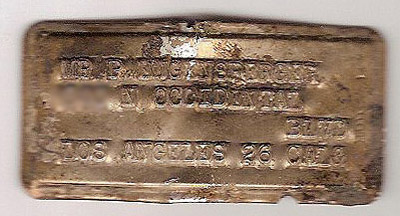Here’s a surname I’m pretty sure doesn’t get sounded out every day: Engensperger. Specifically Mr. P. Engensperger.
Who dat? Good question. Don’t know. But it’s the name on the latest trinket found in the never-ending treasure trove of our backyard. While out cavorting with Ranger (who overnight has taken to fetching the frisbee like she’s been doing it forever) I spied this doubled-over piece of lightweight metal by the hammock that when I unfolded it and dusted it off revealed itself to be a typeset embossed tag of some sort…

…showing the home’s address and the name of a previous resident (owner?), a Mr. P. Engensperger. Of interest in regards to the tag’s potential age is the last line that reads:
LOS ANGELES 26 CAL&
It could be argued that the use of the last two digits of the zip code was for space reasons, but I’ll bet this plate was made back when two-digit postal “zone numbers” were the order of the day, which means prior to 1963 when the national five-digit system was installed. The “26” being placed after the city instead of after the state would support this as the two-digit postal zone numbers typically indicated smaller local areas (Hollywood 28, for example). Additionally the use of “CAL” as an abbreviation for the state instead of the two-letter abbreviation (a program also implemented in 1963) would indicate this plates age at 43 years or more. But I’ve no clue as to why there’s an ampersand after the “CAL” or what it might represent.
The other notable element on this side is one that can barely be discerned in the rough scan. On the right edge is a vertical arrow with a feathered tail design that’s embossed from the opposite side as the address stamp. On the tag’s flipside and barely readable through the metal’s deterioration (even with an 8X lupe) at the top edge is “FARRINGTON” and at the bottom is “TRADE CHAP-A-PLATE MARK.” A Google search proved unhelpful using either or both terms.
So did a search for “Engensperger.”
 Follow
Follow